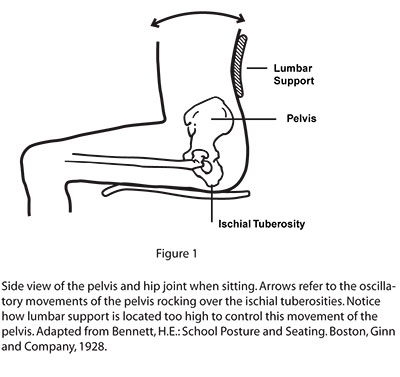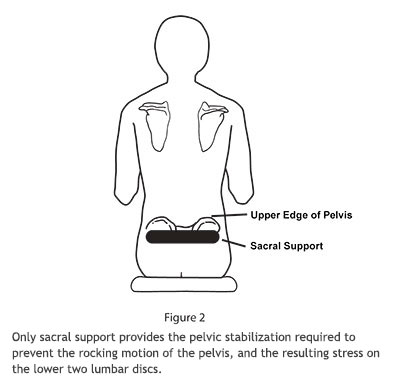3 Reasons to Avoid Driving with Lumbar Support
by Dennis Zacharkow, PT
© 2015
-
Lumbar Support Increases the Risk of Developing a Herniated Lumbar Disc.
This is because lumbar support is located too high to stabilize the pelvis when driving. (As advocated by McKenzie, who started the lumbar support craze among physical therapists, proper lumbar support placement is “at or just above the belt line, affecting approximately the area of the third and fourth lumbar vertebrae.”1)
Without firm pelvic stabilization, a major effect of the vibration and road shock from driving is a rapid rocking of the pelvis over the ischial tuberosities (sitting bones).2-4 This rocking motion of the pelvis localizes the greatest bending motion in the spine to the two lowest lumbar vertebrae: L5 and L4. This correlates with the most frequent level of disc herniation being at L5-S1, the second most frequent at L4-L5.
Lumbar support is located too high to prevent the rocking motion of the pelvis, and the resulting stress on the lower two lumbar discs. (See Figure 1.)

-
Lumbar Support Does Not Correct a Slumped Driving Posture.
According to lumbar support advocates, a slumped driving posture results from extreme flexion of the lumbar spine. Therefore, the solution to slumping is simply to add a lumbar support.
However, recent research shows this focus on the lumbar spine when slumping to be incorrect. Nairn et al. (2013)5 found that slumped sitting is characterized by nearly full flexion of the lower thoracic spine and mid-thoracic spine, but only mid-range flexion of the lumbar spine.
So, it is not the lumbar spine but the lower thoracic and mid-thoracic regions that are actually near the end-range of flexion. This study emphasizes the more important role of the thoracic spine compared to the lumbar spine in slumped sitting.
-
Driving With Lumbar Support Ruins Your Standing Posture.
Driving with lumbar support displaces the upper trunk behind the hips. This moves the driver further away from the steering wheel and windshield. The driver usually adapts to this postural distortion by increasing the thoracic kyphosis, rounding the shoulders, and bringing the head forward.6
Lumbar support also results in a relaxation and overstretching of the deep lower abdominal muscles, critical postural muscles for both sitting and standing posture.7
As Kellogg8 stated back in 1927, “The standing posture is in general simply the natural result of the sitting posture.”
The more hours spent driving with lumbar support, the faster the distorted transformation of one’s standing posture with the characteristic forward head, round back, round shoulders, and protruding abdomen.9
So, forget about lumbar support because:
Sacral support is the most important feature for preventing a herniated lumbar disc from driving.10
(See Figure 2.)
- Lower thoracic support is the most important feature for correcting a slumped driving posture.
Lower thoracic support corrects the main cause of a round back, round shoulders, and forward head posture – the hinging forward and downward of the rib cage due to flexion of the lower thoracic spine.
The lower thoracic spine (just below the shoulder blades) is the true “hinge area” for spinal flexion – not the lumbar spine!11-17 (See Figure 3.)
 Figure 3:
Figure 3:
Circle denotes area of the thoracic spine responsible for the hinging forward and downward of the rib cage. Adapted from Bennett, H.E.: School Posture and Seating. Boston, Ginn and Company, 1928.
References
- McKenzie, R.A.: The Lumbar Spine. Mechanical Diagnosis and Therapy. Waikanae, Spinal Publications, 1981.
- Branton, P.: The Comfort of Easy Chairs. Stevenage, Hertfordshire, England, The Furniture Industry Research Association, 1966.
- Branton, P.: Behaviour, body mechanics and discomfort. In Grandjean, E. (Ed.): Proceedings of the Symposium on Sitting Posture. London, Taylor and Francis, 1969, pp. 202-213.
- Sandover, J., and Dupuis, H.: A reanalysis of spinal motion during vibration. Ergonomics, 30:975-985, 1987.
- Nairn, B.C., Chisholm, S.R., and Drake, J.D.: What is slumped sitting? A kinematic and electromyographical evaluation. Manual Therapy, 18(6):498-505, December 2013.
- Zacharkow, D.: Women’s driving posture: an overlooked health issue. Worldwide Spine and Industrial Rehabilitation, 1(2):5-10, Fall 2001. (Available online.)
- Zacharkow, D.: Posture: Sitting, Standing, Chair Design and Exercise. Springfield, Thomas, 1988.
- Kellogg, J.H.: Observations on the relations of posture to health and a new method of studying posture and development. The Bulletin of the Battle Creek Sanitarium and Hospital Clinic, 22:193-216, 1927.
- Hawley, G.: The Kinesiology of Corrective Exercise. Philadelphia, Lea and Febiger, 1937.
- Zacharkow, D.: Driving with Sacral Support: The Key to Preventing a Herniated Lumbar Disc. 2013. (Available online.)
- Latham, F.: A study in body ballistics: seat ejection. Proceedings of the Royal Society of London, Series B, 147:121-139, 1957.
- Rathbone, J.L.: Corrective Physical Education. Philadelphia, Saunders, 1934.
- Humphry, G.M.: A Treatise on the Human Skeleton. Cambridge, MacMillan, 1858.
- Vulcan, A.P., King, A.I., and Nakamura, G.S.: Effects of bending on the vertebral column during +Gz acceleration. Aerospace Medicine, 41:294-300, 1970.
- Alexander, C.J.: Scheuermann’s disease. Skeletal Radiology. 1:209-221, 1977.
- Markolf, K.L.: Deformation of the thoracolumbar intervertebral joints in response to external loads. The Journal of Bone and Joint Surgery, 54-A:511-533, 1972.
- White, A.A., and Panjabi, M.M.: Clinical Biomechanics of the Spine. Philadelphia, Lippincott, 1978, p.84.